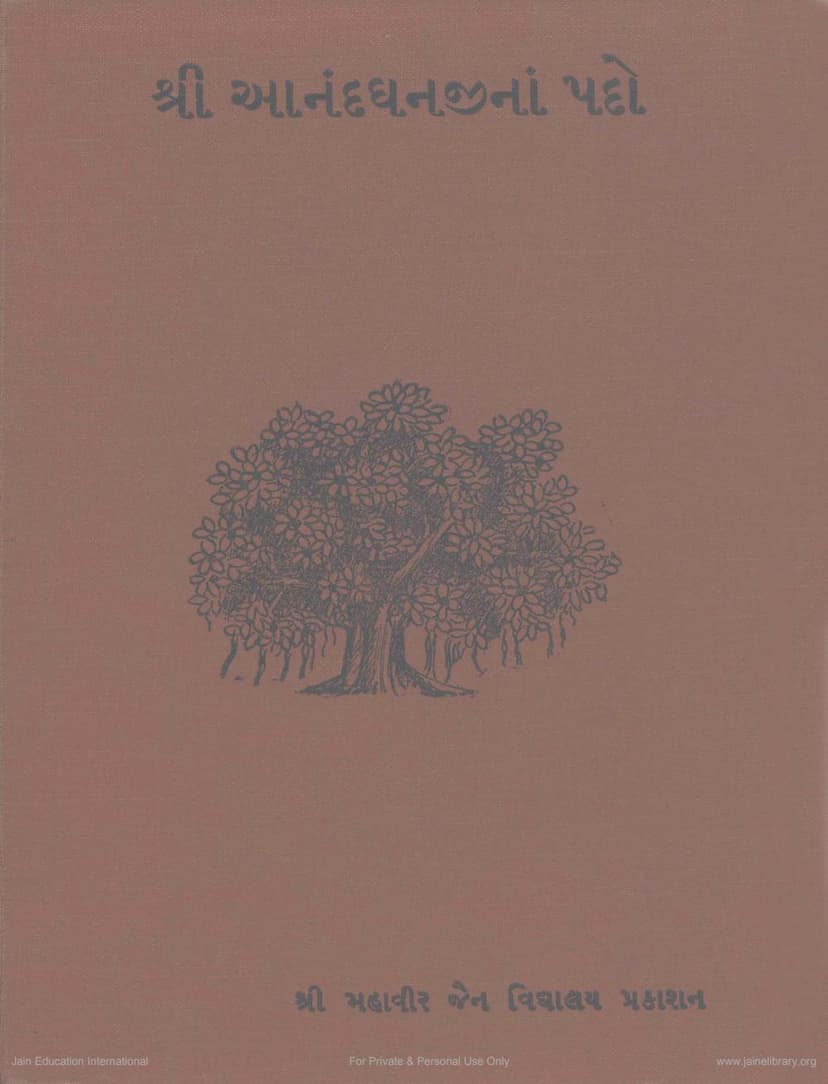Anandghanji Pado
Added to library: September 1, 2025

Summary
Certainly! Here's a comprehensive summary of the Jain text "Anandghanji Pado" based on the provided pages:
Book Title: Anandghanji Pado (The Padas of Anandghanji) Author: Anandghan, Motichand Girdharlal Kapadia (as the author of the commentary) Publisher: Mahavir Jain Vidyalay Catalog Link: https://jainqq.org/explore/004508/1
Overall Summary:
"Anandghanji Pado" is a significant Jain text that presents and elaborates upon the devotional and philosophical songs (padas) composed by the revered Jain monk, Anandghanji. The book, published by Mahavir Jain Vidyalay and authored with extensive commentary by the late Motichand Girdharlal Kapadia, aims to make the profound spiritual and ethical teachings embedded in Anandghanji's padas accessible to a wider audience.
The text is structured to provide not only the original padas in Gujarati and Hindi but also detailed explanations of their meaning, context, and deeper philosophical interpretations. The padas themselves are noted for their simplicity yet profoundness, encapsulating core Jain principles such as charity, compassion, knowledge, service to humanity, selflessness, devotion to Jin (Jinas), and detachment. They offer a glimpse into Anandghanji's spiritual practices and his advanced spiritual perspective. The book also includes introductory sections on Anandghanji's life, times, literary contributions, and the historical context in which he lived.
Key Aspects and Contents Highlighted in the Provided Pages:
- Title and Publisher: The title page clearly indicates "Shri Anandghanji Na Pado" (The Padas of Shri Anandghanji) with the publisher being "Shri Mahavir Jain Vidyalay Prakashan."
- Author and Commentary: The late Motichand Girdharlal Kapadia is credited as the author of the detailed commentary, which includes word-meaning (shabdarth), essence (bhavarth), and extensive analysis (vivechan) of fifty padas.
- Content of the Padas: The padas are described as simple yet profound, illustrating virtues such as donation, compassion, knowledge, service to humanity, selflessness, devotion to Jin, and detachment. They also showcase Anandghanji's yogic practices and his spiritual insights.
- Historical and Biographical Context: The book includes an extensive introduction to Anandghanji, his era, his literary activities, and attempts to place him historically, likely around the 17th century (Vikram Samvat). The introduction delves into the challenges of reconstructing historical figures' lives, especially in Jainism, due to the emphasis on spiritual development over personal fame. It highlights the scarcity of direct biographical details for Anandghanji, leading to reliance on legends and traditions, and the importance of understanding the societal and religious context of his time.
- Detailed Analysis: The commentary aims to explain the padas through:
- Shabdarth (Word Meaning): Literal meaning of the words used.
- Bhavarth (Essence/Meaning): The underlying spiritual or ethical message.
- Vivechan (Detailed Commentary/Analysis): In-depth exploration of the padas' philosophical, ethical, and spiritual implications, often drawing connections to Jain scriptures, yoga, and other philosophical traditions.
- Structure and Organization: The provided index (pages 7-8) details the book's comprehensive structure. It includes:
- Publisher's note.
- An extensive preface and introduction discussing Anandghanji, his era, historical context, and the methodology of the commentary.
- A detailed listing of 50 padas, each with its respective page number.
- An alphabetical index of the fifty padas.
- A summary of subjects.
- Linguistic Aspects: The commentary notes the use of prevalent regional languages in Anandghanji's padas, suggesting an attempt to connect with the common people. The analysis of the language reveals a blend of Gujarati, Marwari, and Hindi influences, indicating a possible reflection of his travels and linguistic environment.
- Spiritual and Yogic Themes: The padas are rich with themes of spiritual experience, yoga practices, self-realization, and the pursuit of liberation. The commentary likely explores these themes in relation to Jain philosophy.
- The Role of the Publisher (Mahavir Jain Vidyalay): The publisher's note highlights the deep connection of Mahavir Jain Vidyalay with the late Shri Motichand Kapadia, one of its founders. It mentions that the publication is part of a series commemorating his services and financial contribution towards promoting Jain literature.
- Inspiration and Motivation: The introduction emphasizes the inspiration drawn from spiritual masters like Pt. Gambhirvijay Ganiji, who helped in deciphering the complex language and philosophy of the padas. The effort to make these spiritual songs accessible to musicians and devotees is also mentioned.
- The Importance of Interpretation: The author, Motichand Kapadia, stresses the need for careful and scholarly interpretation, highlighting that a single sentence can hold multiple layers of meaning, and his commentary aims to uncover these profound insights. He acknowledges the contribution of commentators who meticulously preserved notes and insights.
- Specific Padas Discussed: The introduction mentions specific padas that delve into particular philosophical concepts like Naya Nichep (aspects of reality), yoga, and different philosophical schools of thought.
- Anandghanji's Time Period: The introduction attempts to establish Anandghanji's time, placing him around the 17th century Vikram Samvat, correlating it with the flourishing of Jain scholarship and the presence of numerous learned monks during that era.
- Anandghanji's Life and Circumstances: The text acknowledges the lack of concrete historical facts about Anandghanji's personal life, such as his parents, birthplace, or specific dates, but emphasizes the influence of legends and stories surrounding him, suggesting his significant spiritual stature.
- Language Analysis: A significant portion of the introduction and commentary discusses the linguistic nuances of Anandghanji's padas, highlighting the use of words and grammatical structures that suggest influences from Northern India, particularly Marwar and Bundelkhand, alongside Gujarati.
In essence, "Anandghanji Pado" is presented as a comprehensive guide to understanding the spiritual depth of Anandghanji's devotional poetry, offering linguistic, philosophical, and historical context to illuminate his profound message.